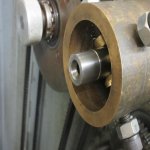I avoid using a steady; the steady I have is from a smaller lathe with a riser I made. It is on the light side. So, as far as possible, I mount barrels through the spindle. Set up once for chambering and threading. I use a spider on the left end of the spindle. Bronze sleeve machined to a push fit on the spindle, with 4 brass tipped clamping screws. On the right end, a 4 jaw chuck with a brass ring over the barrel.
I start off by centering the muzzle end in the spider, the chamber end being supported by the tailstock center. Then I indicate in the bore at the chamber end. Return to the muzzle and indicate it in on the bore. Back to the chamber end, confirm that it is true. I use ground dowel pins in the bore for the indicator to contact, have a selection of gauge pins for the common bore sizes. These do not extend all that far into the bore. Once I am satisfied with the setup, I'll start cutting. If I want to remove metal before reaming, I'll use a boring tool.
I use the same measurements as described above, taking measurements off the GO gauge as the chamber approaches full depth. I ream at low rpms, pulling the reamer by sliding the tail stock, as above, holding it in line. Currently I'm using a cutting fluid "Buttercut", have also used other similar products. I pull and clean the reamer and chamber every tenth of an inch, until the chamber is getting close to depth. I do not polish chambers, just clean them.
I use a commercial reamer holder, feed pressure is applied very much like guntech's system.
Reverse the barrel for cutting, threading and crowning. If I am installing a brake, the threads are cut co-axial with the bore, the brake is installed, and bored to size.
I start off by centering the muzzle end in the spider, the chamber end being supported by the tailstock center. Then I indicate in the bore at the chamber end. Return to the muzzle and indicate it in on the bore. Back to the chamber end, confirm that it is true. I use ground dowel pins in the bore for the indicator to contact, have a selection of gauge pins for the common bore sizes. These do not extend all that far into the bore. Once I am satisfied with the setup, I'll start cutting. If I want to remove metal before reaming, I'll use a boring tool.
I use the same measurements as described above, taking measurements off the GO gauge as the chamber approaches full depth. I ream at low rpms, pulling the reamer by sliding the tail stock, as above, holding it in line. Currently I'm using a cutting fluid "Buttercut", have also used other similar products. I pull and clean the reamer and chamber every tenth of an inch, until the chamber is getting close to depth. I do not polish chambers, just clean them.
I use a commercial reamer holder, feed pressure is applied very much like guntech's system.
Reverse the barrel for cutting, threading and crowning. If I am installing a brake, the threads are cut co-axial with the bore, the brake is installed, and bored to size.









































































